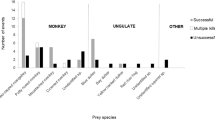Abstract
Eighteen predatory and two cannibalistic episodes have been observed among wild chimpanzees of the Mahale Mountains. The prey consists mainly of juveniles of medium-sized mammals, six species of which were recorded as prey fauna for the first time in this study. Predatory behavior of Mahale chimpanzees seems more opportunistic and primitive than has ever been observed in the Gombe National Park in terms of capture technique, size of prey, co-operation in hunting, sexual difference in capture frequency, degree of consumption and extent of meat sharing. Cannibalism is an inter-unit-group phenomenon and may be an extension of infanticide, which may function in changing “mother” into “female.”
Similar content being viewed by others
References
Altmann, S. A. &J. Altmann, 1970.Baboon Ecology, S. Karger, Basel.
Bygott, D., 1972. Cannibalism among wild chimpanzees.Nature, 238: 410–411.
Goodall, J., 1963. Feeding behaviour of wild chimpanzees: A preliminary report.Symp. Zool. Soc. Lond., 10: 39–47.
Haddow, A. J., 1952. Field and laboratory studies on an African monkey,Cercopithecus ascanius schmidti Matschie.Proc. Zool. Soc. Lond., 122: 297–394.
Harding, R. S. O., 1973. Predation by a troop of olive baboons (Papio anubis).Am. J. Phys. Anthrop., 38: 587–592.
Hausfater, G., 1976. Predatory behavior of yellow baboons.Behaviour, 56: 44–68.
Izawa, K. &J. Itani, 1966. Chimpanzees in the Kasakati Basin, Tanganyika: I. Ecological study in the rainy season 1963–1964.Kyoto Univ. Afr. Studies, 1: 73–156.
Kawabe, M., 1966. One observed case of hunting behavior among wild chimpanzees living in the savanna woodland of western Tanzania.Primates, 7: 393–396.
Kingdon, J., 1974.East African Mammals: An Atlas of Evolution in Africa, Vol. II, Part B (Hares & Rodents), Academic Press, London.
Lawick-Goodall, J. van, 1968. The behaviour of free-living chimpanzees in the Gombe Stream Reserve.Anim. Behav. Monogr., 1: 161–311.
————, 1971.In the Shadow of Man, Collins, London.
Lee, R., 1968. What hunters do for a living, or how to make out on scarce resources. In:Man the Hunter,R. Lee &I. DeVore (eds.), Aldine, Chicago, pp. 30–48.
Manley, G. H., 1966. Prosimians as laboratory animals.Symp. Zool. Soc. Lond., 17: 11–39.
Nishida, T., 1968. The social group of wild chimpanzees in the Mahali Mountains.Primates, 9: 167–224.
————, 1972. A note on the ecology of the red-colobus monkeys (Colobus badius tephrosceles) living in the Mahali Mountains.Primates, 13: 57–64.
————, 1973.Seirei no Kodomotachi (Children of the Mountain Spirits), Chikuma-Shobo, Tokyo. (in Japanese)
————, 1974. Yasei-chinpanjii no Seitai (Ecology of Wild Chimpanzees). In:Jinrui no Seitai (Human Ecology),R. Ohtsuka et al., (eds.), Kyoritsu-Shuppan, Tokyo, pp. 15–60. (in Japanese)
----, 1975 ms. General survey of the Ugalla Area during the dry season of 1975 (Preliminary draft). Mahale Mountains Chimpanzee Research Project, Survey Report No. 2.
————, 1972. Inter-unit-group relationships among wild chimpanzees of the Mahali Mountains.Kyoto Univ. Afr. Studies, 7: 131–169.
Strum, S. C., 1975. Primate predation: Interim report on the development of a tradition in a troop of olive baboons.Science, 187: 755–575.
Sugiyama, Y., 1965. On the social change of hanuman langurs (Presbytis entellus) in their natural condition.Primates, 6: 381–429.
Suzuki, A., 1971. Carnivority and cannibalism observed among forest-living chimpanzees.J. Anthrop. Soc. Nippon, 79: 30–48.
————, 1975. The origin of hominid hunting: A primatological perspective. In:Socioecology and Psychology of Primates,R. Tuttle (ed.), Mounton, The Hague/Paris, pp. 259–278.
Teleki, G., 1973.The Predatory Behavior of Wild Chimpanzees, Bucknell Univ. Press, Lewisburg.
————, 1975. Primate subsistence patterns: Collector-predators and gatherer-hunters.J. Human Evol., 4: 125–184.
Walker, E. P. &J. L. Paradiso, 1968.Mammals of the World. (2nd Ed.), The Johns Hopkins Univ. Press, Baltimore.
Wrangham, R., 1974. Artificial feeding of chimpanzees and baboons in their natural habitat.Anim. Behav., 22: 83–93.
Author information
Authors and Affiliations
Additional information
This study was financed mainly by the Overseas Scientific Research Fund of the Ministry of Education, Japan and partly by the Japan International Co-operation Agency and the Ministry of Natural Resources and Tourism, Tanzania.
About this article
Cite this article
Nishida, T., Uehara, S. & Nyundo, R. Predatory behavior among wild chimpanzees of the mahale mountains. Primates 20, 1–20 (1979). https://doi.org/10.1007/BF02373826
Received:
Accepted:
Issue Date:
DOI: https://doi.org/10.1007/BF02373826




